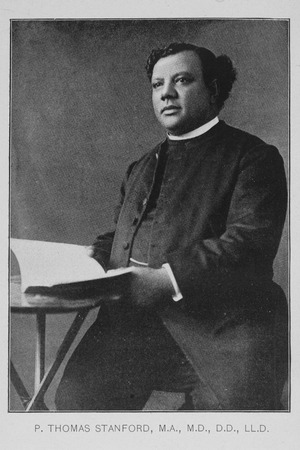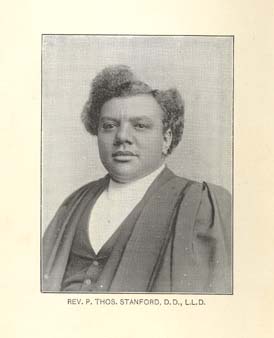Peter Thomas Stanford facts for kids
Quick facts for kids
Peter Thomas Stanford
|
|
|---|---|
 |
|
| Born | February 21, 1858 Hampton, VA
|
| Died | May 20, 1909 North Cambridge, MA
|
Peter Thomas Stanford (born February 21, 1858 – died May 20, 1909) was an African American minister and writer. He was born into slavery near Hampton, Virginia. When he was very young, his parents were sold to other plantations, which made him an orphan.
As a child, he may have lived for a short time with the Pamunkey Native American Tribe. In 1866, the Freedmen's Bureau helped him get adopted by a white family in Boston. However, his adoptive family did not treat him well. In 1871, when he was about 13 or 14 years old, Stanford bravely escaped by hiding in a train's coal box. He arrived in New York City and found freedom. Throughout his life, he became an important activist, writer, and helper of others in America, Canada, and England. He worked hard to fight against slavery and racial violence.
After his difficult childhood, Stanford spent 30 years speaking out against slavery and unfair treatment. He wrote many articles, sermons, and essays that were published in newspapers and magazines across the Atlantic Ocean. He was inspired by other Black activists like Ida B. Wells, Booker T. Washington, and Frederick Douglass. His writings are an important part of the history of African American literature that fought against slavery.
Contents
Peter Stanford's Early Life
Peter Stanford never knew his father, who was sold before Peter was born. When he was a toddler, his mother, Caroline, was also sold, making him an orphan. As a young child, Stanford said he lived for two years with Indigenous people, likely the Pamunkey Native American tribe. He even included some untranslated songs in their language in one of his books, The Plea (1885).
Around 1866, the Freedmen’s Bureau sent young Stanford to Boston. He was adopted by a white couple. Sadly, he was overworked and not given enough food, which was a very hard situation for him. In 1871, he ran away from this difficult home and arrived in New York. There, he found people who helped him. They helped him find work and learn to read and write English. Among these helpers were the Brooklyn pastor Henry Highland Garnet and the famous writer Harriet Beecher Stowe.
Stanford's Religious Work
In 1875, Stanford became a Christian. By 1880, he was one of the first African Americans to graduate from Connecticut’s Suffolk Institute. After that, Stanford became a pastor for African American churches in Hartford, Connecticut.
In 1881, he went to Ontario, Canada, because the Amherstburg Baptist Association (ABA) asked him to. In May 1883, the ABA also asked him to travel by ship from Canada to Liverpool, England. Once in England, Stanford became well-known. He became the first African American minister in Birmingham, England, at the Hope Street Chapel (which is now Highgate Baptist Church). In 1895, Stanford returned to America, where he lived for the rest of his life. He only visited England briefly one more time.
Helping Others and Community Work
Stanford and his first wife, Beatrice Stickley, were active members of The Society for the Recognition of the Universal Brotherhood of Man (SRBM). This group was founded by Catherine Impey and published journals that fought against racism.
In 1897, Stanford started the St. Mark’s Congregational Church of Roxbury, which was the first African American church in Boston. He also founded the Interdenominational Ministers Association of Boston. In North Cambridge, Massachusetts, he organized an orphanage and a school for single women and girls. This place was known at one point as the Union Industrial and Strangers’ Home. Stanford also discussed politics with William Monroe Trotter, a civil rights activist and founder of Boston’s Guardian newspaper. He served as vice-president of Baltimore’s Christ’s Medical and Chirurgical College and was the editor of its 1909 journal. Stanford was also the vice-president for the National Baptist Convention of Massachusetts.
Stanford's Beliefs
In his 1898 book, The Tragedy of the Negro in America, Stanford wrote about the history of Black people in America. He saw it as a "journey toward freedom." He believed that God had a plan that would eventually lead to freedom for Africa and much of the rest of the world. He had a hopeful view for the future.
Peter Stanford's Family Life
Stanford married his wife Beatrice Mabel Stickley (born around 1868 – died 1900) while he was living in England. They had a daughter together named Carolyn. After Beatrice passed away in 1900, Stanford married Myra Elizabeth Matthews, who was a music teacher in America.
In 1907, Stanford moved to Auburn, New York, to work with Harriet Tubman. They planned to develop an orphanage together. When his health started to get worse, he returned to his home in North Cambridge, Massachusetts.
Peter Thomas Stanford passed away on May 20, 1909, in North Cambridge, due to kidney failure.
Peter Stanford's Writings
- The Plea of the Ex-Slaves Now in Canada (1885)
- The Tragedy of the Negro in America (1897, 1897, 1903)
- Other writings were published in newspapers like The Cambridge Chronicle, The Muskogee, the Daily Phoenix, and the Birmingham [UK] Gazette.
Images for kids



